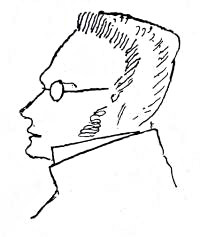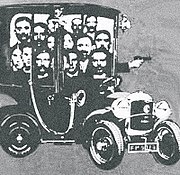Illegalism
| Part of a series on |
| Anarchism |
|---|
 |
|

Illegalism is a tendency of anarchism that developed primarily in France, Italy, Belgium and Switzerland during the early 1900s as an outgrowth of individualist anarchism.[1][2] Illegalists embrace criminality either openly or secretly as a lifestyle. Illegalism does not specify the type of crime, though it is associated with theft and shoplifting.
Illegalism is founded on egoist anarchism and the philosophy of Max Stirner as justification for criminal behaviour. However, not all illegalists are supporters of Stirner and his philosophy. Jules Bonnot and the Bonnot Gang are recognised as notable illegalists. As left-wing anarchists, the illegalists strongly oppose wage labour and markets.[3]
Emergence[]
Illegalism first rose to prominence among a generation of Europeans inspired by the unrest of the 1890s, during which Ravachol, Émile Henry, Auguste Vaillant and Caserio committed daring crimes in the name of anarchism, in what is known as propaganda of the deed.
Influenced by theorist Max Stirner's egoism,[4] the illegalists in France broke from anarchists like Clément Duval and Marius Jacob who justified theft with a theory of individual reclamation (la reprise individuelle). Instead, the illegalists argued that their actions required no moral basis and illegal acts were taken not in the name of a higher ideal, but in pursuit of one's own desires. In Paris, this milieu was centred on the weekly papers L'Anarchie and the Causeries Populaires (regular discussion groups meeting in several different locations in and around the capital each week), both of which were founded by Albert Libertad and his associates.[5]

After Peter Kropotkin along with others decided to enter labor unions after their initial reservations,[6] there remained the anti-syndicalist anarchist-communists, who in France were grouped around Sébastien Faure's Le Libertaire. From 1905 onwards, the Russian counterparts of these anti-syndicalist anarchist-communists become partisans of economic terrorism and illegal expropriations.[6] Illegalism as a practice emerged and within it "[t]he acts of the anarchist bombers and assassins ("propaganda by the deed") and the anarchist burglars ("individual reappropriation") expressed their desperation and their personal, violent rejection of an intolerable society. Moreover, they were clearly meant to be exemplary, invitations to revolt".[7] In another less dramatic sense, "[at] that time this term was used to indicate all those practices prohibited by law that were useful for resolving the economic problems of comrades: robbery, theft, smuggling, counterfeiting money and so on".[8]
Such acts of rebellion which could be individual[7] were in the long run seen as acts of rebellion which could ignite a mass insurrection leading to revolution. Proponents and activists of this tactic among others included Johann Most, Luigi Galleani, Victor Serge and Severino Di Giovanni. In Argentina, these tendencies flourished at the end of the 1920s and during the 1930s, "years of acute repression and of flinching of the once powerful workers movement—this was a desperation, though heroic, of a decadent movement".[9]

France's Bonnot Gang was the most famous group to embrace illegalism. The Bonnot Gang (La Bande à Bonnot) was a French criminal anarchist group that operated in France and Belgium during the Belle Époque from 1911 to 1912. Composed of individuals who identified with the emerging illegalist milieu, the gang utilized cutting-edge technology (including automobiles and repeating rifles) not yet available to the French police.
Originally referred to by the press as simply "The Auto Bandits", the gang was dubbed "The Bonnot Gang" after Jules Bonnot gave an interview at the office of Petit Parisien, a popular daily paper. Bonnot's perceived prominence within the group was later reinforced by his high-profile death during a shootout with French police in Nogent-sur-Marne.
Criticism[]
Following his arrest for harbouring members of the Bonnot Gang, Victor Serge, once a forceful defender of illegalism, became a sharp critic. In Memoirs of a Revolutionary, he describes illegalism as "a collective suicide".[10] Similarly, Marius Jacob reflected in 1948: "I don't think that illegalism can free the individual in present-day society... Basically, illegalism, considered as an act of revolt, is more a matter of temperament than of doctrine".[11]
Influence[]
Horst Fantazzini[12] was an Italian-German individualist anarchist[13] who pursued an illegalist lifestyle and practice until his death in 2001. He gained media notoriety mainly due to his many bank robberies through Italy and other countries.[12] In 1999, the film based on his life Ormai è fatta! was released.[14]
See also[]
- Alfredo M. Bonanno
- Amoralism
- Egoism
- Expropriative anarchism
- Insurrectionary anarchism
- Piracy
- Propaganda of the deed
- Social bandits
References[]
- ^ "The illegalisis in this study,...As anarchist individualists, they came from a milieu whose most important theoretical inspiration was undoubtedly Max Stimer—whose work The Ego and Its Own remains the most powerful negation of the State, and affirmation of the individual, to date."—Richard Parry, The Bonnot Gang: the history of the French illegalists], 1987, p. 5.
- ^ "Parallel to the social, collectivist anarchist current there was an individualist one whose partisans emphasized their individual freedom and advised other individuals to do the same...Some individualists rebelled by withdrawing from the economy and forming voluntary associations to achieve self-sufficiency. Others took the route of illegalism, attacking the economy through the direct individual reappropriation of wealth. Thus theft, counterfeiting, swindling and robbery became a way of life for hundreds of individualists, as it was already for countless thousands of proletarians.—"The "Illegalists"" by Doug Imrie (from Anarchy: A Journal of Desire Armed, Fall-Winter, 1994–95)
- ^ Bonanno, Alfredo. "Armed Joy". The Anarchist Library. Retrieved 18 July 2020.
- ^ "a new generation of anarchists, spurred on by the individualist' ideas of Max Stirner, were to take as their point of departure exactly what Jean Grave objected to, that the rebel who secretly stole was no more than an ordinary thief. The developing theory of 'illegalism^ had no moral basis> recognizing only the reality of might in place of a theory of 'right'. Illegal acts were to be done simply to satisfy one's desires, not for the greater glory of some external 'ideal'. The illegalists were to make a theory of theft without the embarrassment of theoretical justifications." — Richard Parry. The Bonnot Gang: the history of the French illegalists. 1987.
- ^ Richard Parry. The Bonnot Gang: the history of the French illegalists. 1987. p. 5.
- ^ Jump up to: a b "This inability to break definitively with collectivism in all its forms also exhibited itself over the question of the workers' movement, which divided anarchist-communism into a number of tendencies." "Anarchist-Communism" by Alain Pengam Archived 2009-03-12 at the Wayback Machine
- ^ Jump up to: a b "The "illegalists" by Doug Imrie. From "Anarchy: a Journal Of Desire Armed", Fall–Winter, 1994–95 Archived 2015-09-08 at the Wayback Machine
- ^ "Beyond the Law" by Penelope Nin on Various Authors Articles from “Canenero”
- ^ Collin Sick. "Notes on the article "Anarchism, Insurrections and Insurrectionalism"". Archived from the original on 2012-09-21.
- ^ Memoirs of a Revolutionary, by Victor Serge
- ^ The "Illegalists" Archived 2015-09-08 at the Wayback Machine, by Doug Imrie (published by Anarchy: A Journal of Desire Armed)
- ^ Jump up to: a b "Horst Biography"
- ^ "He always considered himself an individualist anarchist." "Horst Biography"
- ^ "Ormai è fatta!" (1999) at the IMDB
Further reading[]
- Parry, Richard (1986). The Bonnot Gang. Rebel Press. ISBN 0-946061-04-1.[1].
- "The "illegalists" by Doug Imrie. From "Anarchy: a Journal Of Desire Armed", Fall-Winter, 1994-95.
- Cacucci, Pino (July 25, 2006). Without a Glimmer of Remorse. Christie Books. ISBN 1-873976-28-3.
- On Illegalism and Ultra-Leftism. Philippe Gavi, J-P Sartre, & Pierre Victor. Gallimard, Paris, 1974.
- "Illegalism and Insurrectionary Anarchism" by Freedom.
- Illegalism
- Anarchist schools of thought
- Individualist anarchism
- Anarchist movements
- Crime
- Anarchism in France
